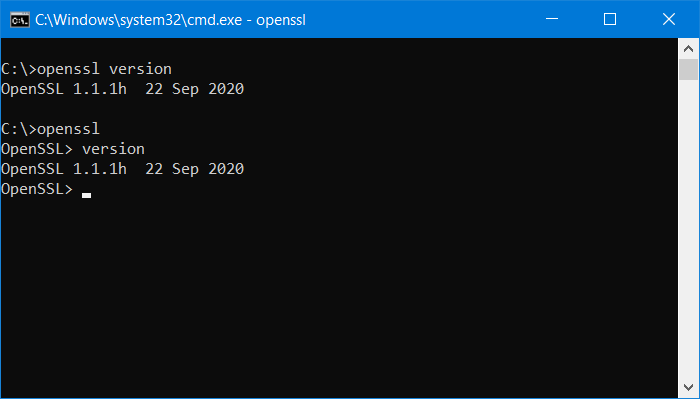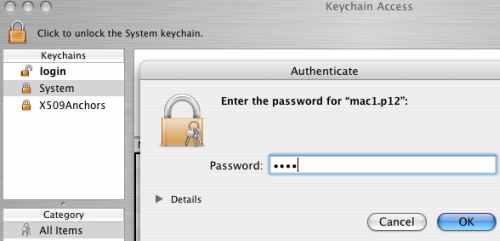

- #OPENSSL FOR MAC OS X MAC OS X#
- #OPENSSL FOR MAC OS X INSTALL#
- #OPENSSL FOR MAC OS X UPGRADE#
- #OPENSSL FOR MAC OS X SOFTWARE#
- #OPENSSL FOR MAC OS X PASSWORD#
OpenSSL commands openssl genrsa -out key.pem 2048
#OPENSSL FOR MAC OS X MAC OS X#
OpenSSL comes installed with Mac OS X (but see below),Īs well as many Linux and Unix distributions.Ĭreating a certificate with it is very easy. For more about file security follow us on Twitter, Facebook and sign up for our newsletter.Creating a self-signed certificate with OpenSSL The file will remain unreadable until it has been decrypted through OpenSSL again.
#OPENSSL FOR MAC OS X PASSWORD#
If you are wondering what happens when the password is invalid, you’ll get an error message, but if you force open the file with something like TextEdit, you’ll see the text encrypted version followed by a bunch of gibberish like so: Other than switching the placement of the input and output, where again the original file stays put, the main difference here is the -d flag which tells OpenSSL to decrypt the file. Once you execute the command above, you will be asked for the password you used. In the previous section, we set password will be required to decrypt the file. Decrypting Files with OpenSSL openssl des3 -d -in encrypted.txt -out normal.txt This means the original file will stick around either before or after encryption, and you will want to deal with that file individually, preferably through a secure delete method. To prevent any unexpected problems, do not specify the same file as the input and output.

You will be asked to set and confirm a password before the encryption is complete, do not lose this password or you will lose access to the file.Īdditionally, you can also just use an input file within filename, but that may cause issues. openssl des3 -in file.txt -out encrypted.txt Here is what the command would look like: des3 which is short for Triple Data Encryption Standard (DES) is a type of computerized cryptography where block cipher algorithms are applied three times to each data block. We’re also going to specify a different output file to prevent any errors. We’ll be using the des3 encryption algorithm for this example, and we’ll be using a text file as the input. The syntax for using OpenSSL is pretty basic: It starts with the command openssl and you specify the type of encryption, and then you add the file that needs to be encrypted. With OpenSSL installed and verified on our system, we can so ahead and use it to encrypt and decrypt individual files.
#OPENSSL FOR MAC OS X INSTALL#
By running the commands below you will have OpenSSL installed and linked correctly on a Mac brew install openssl To install OpenSSL on a Mac we will be using homebrew. If you don’t have it installed, you can just use the commands below to install it and all it’s associated development libraries. This should display all information related to the version of OpenSSL you have installed on your computer, it should be similar to the output below: LibreSSL 2.2.7 If you want to verify which version of OpenSSL you have installed, you can do that easily by typing the command below in your terminal. Most versions of Ubuntu come with OpenSSL installed, it is usually not the latest version but just as mentioned above it you can use it for this tutorial. While we will be focusing on Mac OS X and Ubuntu in this article, these commands will work anywhere that OpenSSL is installed, including older versions of OS X, CentOS, and all other Linux variants. Since OpenSSL allows us to specify the encryption algorithm to use, we’ll use the des3 encryption algorithm, which in simple terms means a complex encryption algorithm is applied three times to each data block, making it difficult to crack through brute force methods or other computer hacking methods. Just as mentioned in the title, in this tutorial we will be using OpenSSL in a slightly unusual way, we will be using it to encrypt and decrypt a file on our computer.
#OPENSSL FOR MAC OS X UPGRADE#
You do not need to upgrade to follow this tutorial. An older version will work with the tutorial as well. To get the latest, you must download it yourself and install. The default toolkit of OpenSSL that comes with Ubuntu isn’t the latest. Most network communication apps, personal computers, web servers, cell phone and tools that use TLS/SSL protocols have a version of OpenSSL installed on them.
#OPENSSL FOR MAC OS X SOFTWARE#
The source code of the project lives on GitHub and is managed by a worldwide community of software engineering volunteers with over 300 contributors. OpenSSL is an open source library that provides a full-featured toolkit and APIs for secure computer network communication over Transport Layer Security (TLS) and Secure Sockets Layer (SSL) protocols on Linux and other Unix-like systems


 0 kommentar(er)
0 kommentar(er)
